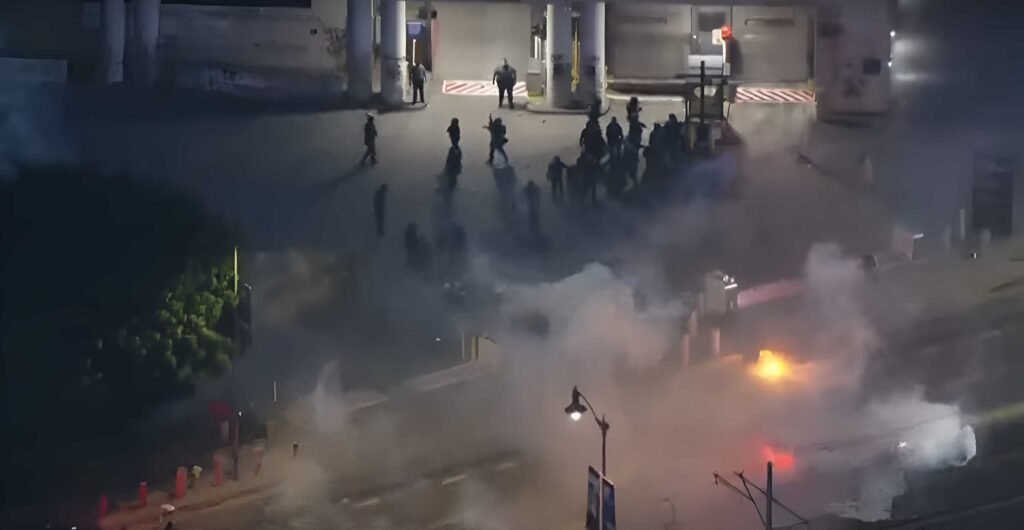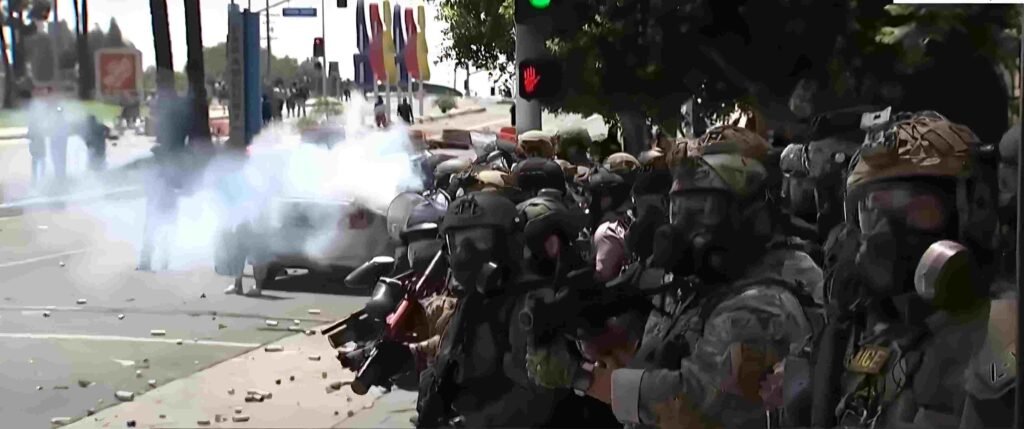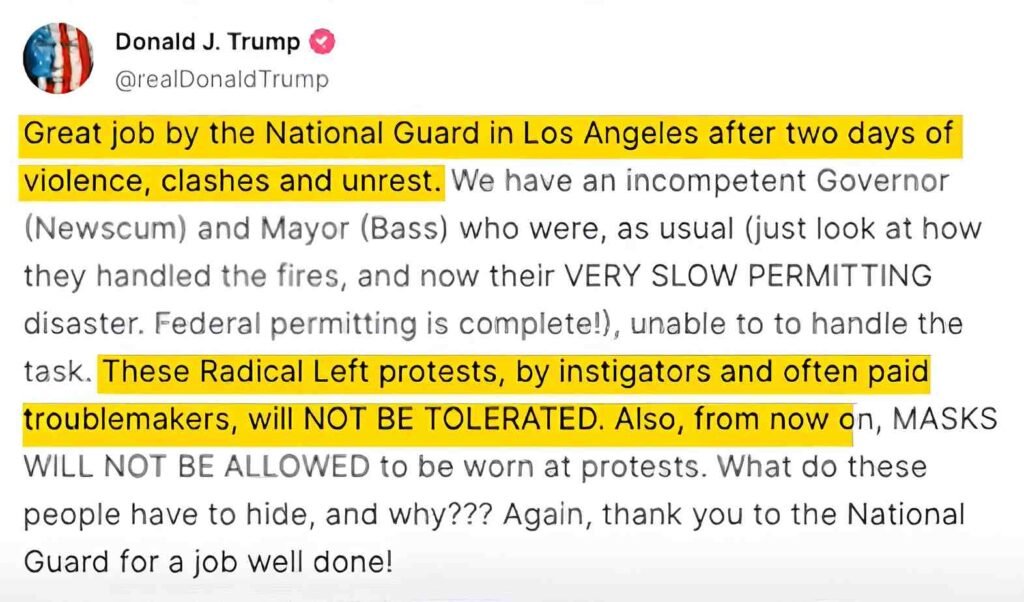Tensions flared across Los Angeles this weekend as federal immigration authorities carried out sweeping operations that resulted in dozens of arrests and a fierce response from residents, local officials, and immigrant rights groups. What began as isolated reports of ICE activity quickly escalated into a full-blown political crisis, as President Donald Trump ordered the deployment of National Guard troops to the city, claiming local leaders had failed to maintain control.
The Raids Begin

On Friday morning, U.S. Immigration and Customs Enforcement (ICE) agents launched coordinated immigration enforcement actions in multiple neighborhoods across Los Angeles. According to an official ICE statement, the operations involved executing four federal search warrants at three separate locations in central L.A. Initial reports indicated that 44 people were arrested, although some sources later reported that the number had increased to over 120 by late Saturday.
ICE claimed the actions were standard deportation efforts. However, video footage and eyewitness accounts painted a more chaotic picture. Federal agents were seen clashing with protesters, forcibly clearing streets, and making arrests near areas like the Garment District and a Home Depot in Westlake. The raids sparked immediate protests, with immigrant rights activists accusing the federal government of using excessive force and targeting non-violent individuals.
Protests and Clashes Erupt

By Friday evening, the protests had grown in size and intensity. Hundreds gathered near the federal detention center and in neighborhoods like Paramount, a small city southeast of L.A., where tensions reached a boiling point. Demonstrators accused ICE agents of inciting panic in predominantly immigrant communities.
According to the L.A. County Sheriff’s Department, protesters in Paramount clashed with law enforcement, throwing bottles and fireworks. Two deputies were injured, one vehicle was set ablaze, and a strip mall suffered minor fire damage. Authorities made at least one confirmed arrest, though multiple people were detained.
Despite the confrontations, the Los Angeles Police Department (LAPD) maintained that protests in downtown Los Angeles were largely peaceful. In a Saturday night statement, LAPD commended the public for exercising their First Amendment rights responsibly and reiterated that it was not involved in any ICE operations.
Federal Government Steps In

The situation took a dramatic turn when President Donald Trump announced the deployment of at least 2,000 National Guard troops to Los Angeles. In a post on social media, Trump declared:
“If Governor Gavin Newscum, of California, and Mayor Karen Bass, of Los Angeles, can’t do their jobs… then the Federal Government will step in and solve the problem, RIOTS & LOOTERS, the way it should be solved!!!”
The memorandum signed by the President authorized not only National Guard personnel but also “any other members of the regular Armed Forces as necessary” to support federal operations.
California officials, however, pushed back hard.
State and Local Leaders Push Back
Governor Gavin Newsom called the federal deployment “purposefully inflammatory”, warning that it would “only escalate tensions” in a city still haunted by memories of the 1992 civil unrest.
“We’ve been in close coordination with local authorities,” Newsom said. “There is currently no unmet need.”
L.A. Mayor Karen Bass echoed the governor’s concerns, stating:
“One of the worst things you can do during civil unrest is flood the streets with heavily armed law enforcement. That doesn’t calm the public—it agitates them.”
Bass added that her administration was coordinating with immigrant rights organizations and would not tolerate fear tactics that jeopardize the safety of city residents.
Political War of Words
The controversy quickly gained national attention, with competing narratives unfolding across various media channels.
- Fox News and other conservative outlets described the situation as “L.A. Riots”.
- Local officials, however, described the violence as “isolated incidents” and stressed the overall peaceful nature of the protests.
Congresswoman Nanette Barragán, who represents Paramount, firmly stated that no additional federal assistance was needed. She accused the Trump administration of attempting to “terrorize immigrant communities” and distract from other national issues.
“This is not about law and order—it’s about political theater,” Barragán said. “You’re sending the National Guard against the people of your own country. It’s meant to escalate, not protect.”
What the Data Says
This federal action comes after years of rising tensions surrounding immigration enforcement in California. Despite President Joe Biden’s more measured tone on immigration, ICE removals and detentions in Los Angeles have sharply increased in recent years:
- Between 2022 and 2024, ICE removals in Southern California rose by 180%, with over 3,500 individuals deported in 2024 alone.
- Detentions rose by 155% in the same period, with the largest increase seen among individuals with no criminal records.
Activists say the raids have been growing in scale and aggression, despite claims that enforcement would be targeted and restrained.
Know Your Rights and Community Response
Groups like CHIRLA (The Coalition for Humane Immigrant Rights), ACLU, and other organizations have long warned about the potential for mass deportations under Trump. These groups have trained thousands of people on how to assert their rights during raids, distributed “Know Your Rights” red cards, and established hotlines to report ICE activity.
The L.A. Unified School District has supported these efforts by helping distribute informational materials to immigrant families.
What’s Next?
A mass protest is planned outside Los Angeles City Hall on Sunday at 2 p.m. Organizers are calling for a peaceful demonstration and are urging residents to bring attention to what they view as unjust federal aggression.
FAQs
❓Why did ICE conduct raids in L.A.?
ICE claimed the operations were part of regular deportation efforts. However, critics say the timing—during graduation season and Pride Month—was politically motivated and designed to instill fear in immigrant communities.
❓Is the National Guard helping ICE with deportations?
No. Officials say the Guard is deployed to protect federal agents, not participate in immigration enforcement. However, critics argue that their presence intimidates residents and worsens tensions.
❓How many people were arrested?
ICE initially reported 44 arrests, though local reports suggest over 120 by Saturday night. Several activists and even union leaders were among the detained.
❓What are L.A. officials doing?
Mayor Bass, LAPD, and all 15 city council members have condemned the raids and emphasized that L.A. police are not assisting ICE in immigration enforcement. Officials are focused on de-escalating tensions and protecting civil liberties.
Conclusion
The immigration raids in Los Angeles have become more than just a law enforcement issue—they are now a national flashpoint over immigration, states’ rights, and federal overreach. As protests continue and tensions rise, the question remains: Will this moment be remembered as a show of force—or a tipping point for immigration justice in America?

